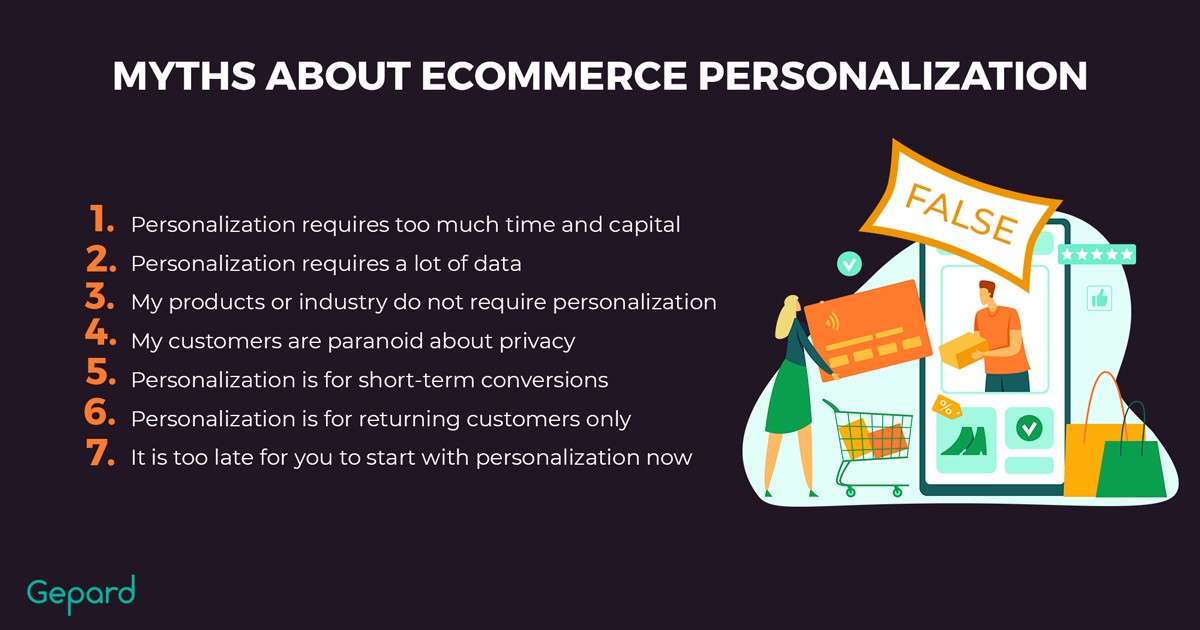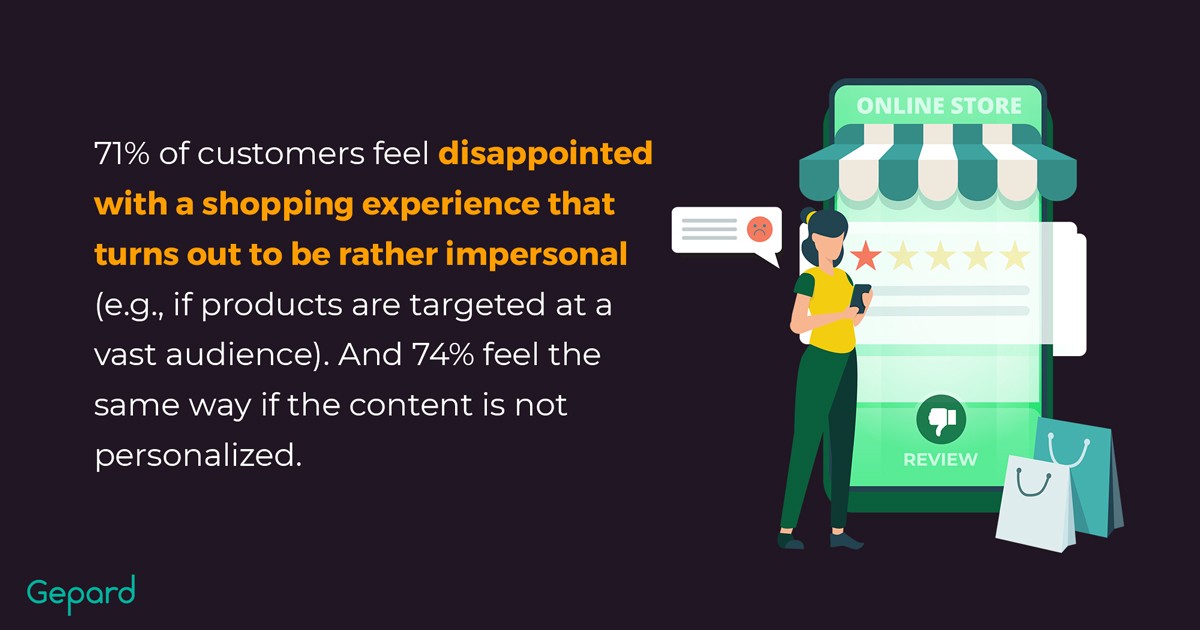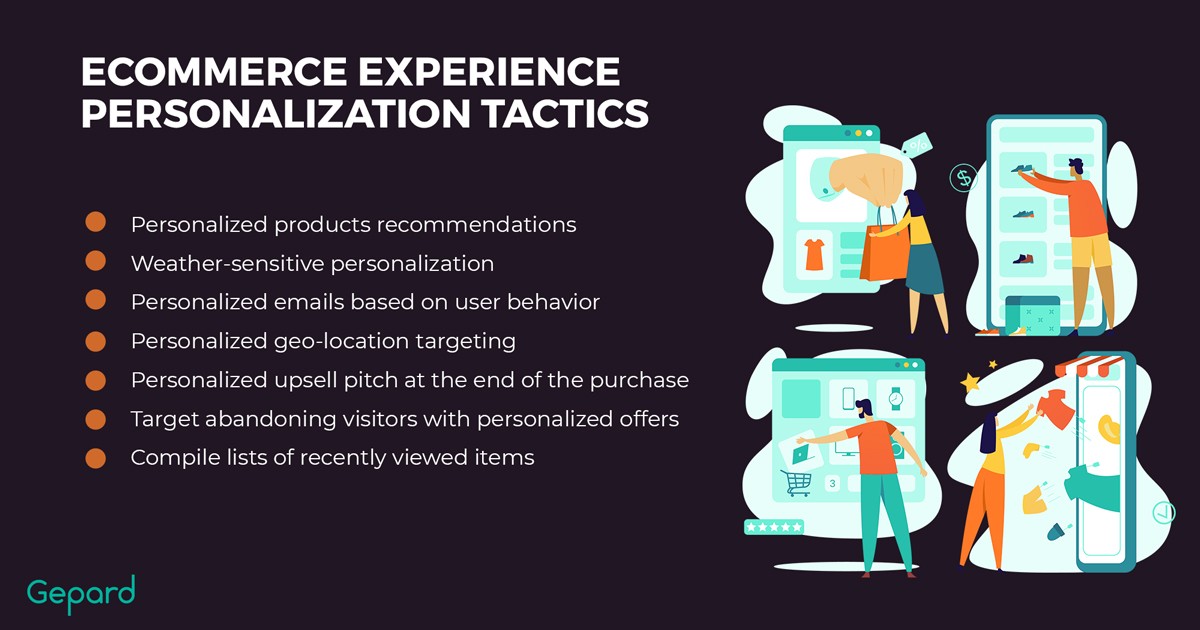An Overview Of Personalization In eCommerce, Its Myths And Best Practices
Personalization in eCommerce is one of the best mechanisms that sell. But how do you achieve this is in your business?
In this article, you’ll learn the myths and facts about personalization, including its benefits, best practices and tactics, and ways of implementing such a strategy. But let’s start with a definition.
What Is Personalization In eCommerce?
Myths About eCommerce Personalization
Personalization is not a new concept. Yet, it’s not so common in the digital space which creates some misconceptions. All these myths are standard and quite easy to bust, so let’s get to it.
Myth #1. Personalization Requires Too Much Time And Capital
It may seem that personalization requires investing in the custom development of complex algorithms.
In reality, the platform you use most likely offers basic eCommerce personalization tools that incorporate the user data they receive. There are also more complex solutions that have free plans, such as Clerk.io and OptiMonk. This is enough to get you started.
Myth #2. Personalization Requires A Lot Of Data
This may be true for specific cases. For example, if you need a lot of content or historical data to draw insights and use them. But most often, you can use real-time data coupled with effective segmentation to direct customers to relevant offers.
Myth #3. My Products Or Industry Do Not Require Personalization
Yes, they don’t because personalization isn’t about your industry or products. It’s about your customers and their experience of interacting with your business — online as much as offline. Think about the offline experiences when a customer is greeted by name and offered their usual choice or something that goes well with their usual preferences.
You can transfer similar events online. Offer a greeting on your homepage to logged in customers and recommendation lists based on their order or browsing history.

Myth #4. My Customers Are Paranoid About Privacy
Some are, but more than half of consumers are ready to share their information if it means a better experience. The rest are cautious about brands misusing their personal data for stalking.
But if you are transparent about what information (e.g., cookies, usage data) you use and how it helps with personalization, chances are that more of your client base won’t mind.
Myth #5. Personalization Is For Short-Term Conversions
While it does offer some short-term benefits, personalization is more than just segmentation for a campaign. It is one of the key factors in building lasting relationships with your clients, which creates an experience that results in high retention rate and brand loyalty.
Myth #6. Personalization Is For Returning Customers Only
This goes back to the point that personalization requires historical data only in some cases. But you can tailor the experience for first-time buyers as well. For example, build recommendations based on the behavior of similar segments, and for that, you need a CMS tool with personalization features, such as Kontent.ai and DotCMS.
Myth #7. It Is Too Late For You To Start Now
There’s no real argument to support this. As the popular saying goes – better late than never.
The aim of any business is to grow and progress – this ensures an even higher ROI. Investing in eCommerce personalization is a way of growing. You can implement it at any time as a growth strategy.
Benefits Of eCommerce Personalization
The myths busting above show that eCommerce personalization can offer long- and short-term benefits to any business and you can implement it at any point.
The following stats should give an inclination about what these benefits can be:
80% of customers desire a personalized shopping experience and 74% feel disappointed if the content is not personalized. People will seek a different retailer if you don’t satisfy this need.
Back in 2016, businesses have lost a whopping $756 billion due to poor personalization.

There’s more so let’s overview some of the most prominent upsides.
1. Improved Conversions By Increased Sales
People need less than a second to decide if they’re going to stay on a website or not. Imagine you open a smartphone product page and see full descriptions complete with images and a list of recommended accessories – a good first impression. The chances you will buy it from this site are higher than if the page only had one photo and a price.
2. Increased Average Order Size
Personalized recommendations help upsell and cross-sell products. For example, if a customer is looking for a laptop, they’re also likely to be interested in a case and earphones. Making these products more accessible while shopping or in the cart makes for a better sale.
3. Increased Engagement With Your Brand
Personalization creates conditions in which customers want to continue interacting with your brand because it makes shopping more convenient. They keep looking at items and related products, but they can easily find what they need so this experience is not frustrating. For example, with time, you’ll be able to offer customers a homepage that shows items that they’ve bought but might be running out or things they’re likely to be interested in while hiding unwanted items.
4. Enhanced Customer Experience
Personalization isn’t just about recommendations, but the overall consumer-faced content. It makes the whole experience from product lists and the shopping cart to ads and emails more relevant. For example, if a customer isn’t interested in gardening equipment, showing ads and discounts on lawnmowers and shovels will only frustrate them. Instead, hiding them will reduce the information overload that haunts almost every single person who uses the internet.
5. Improved Customer Loyalty
In fact, you can personalize loyalty by offering relevant rewards. Using the ever-accumulating customer data and segmentation, you can tailor the type of a loyalty program to the type of customer that it would suit. For example, offering bonus points to a customer who only shops in one category is most likely a miss, but they might be interested in a discount for every third bottle of shampoo.
6. Ensured Competitive Advantage
Of course, if you’re treating your customers better than your competitors do, they are more likely to shop with you and even wait for the products that are out of stock. Personalization in itself is a competitive advantage for a lot of online stores.
But you could, for example, create a “Previously purchased” tab alongside the “Recently viewed items” so users won’t have to get through a dozen of steps to pull that information from the order’s history. That’s a step further into a more convenient shopping experience.
7 eCommerce Experience Personalization Tactics That Work
You may need a few personalization tactics to satisfy your audience. Finding the right one is down to a combination of creativity, empathy, continuous testing and experimentation, as well as the right technology.
But you can also find inspiration in some of the commonly used personalization tactics. Let’s review seven such strategies.
1. Personalized Products Recommendations
You could say that a person looking at an HP printer might also need ink. But that’s a loose prediction, recommendations work differently.
Product recommendation algorithms take into account different customer data – including their order and search history, location, and products viewed – to find items that they will be most interested in. There are a few types of algorithm engines here:
- Collaborative filtering – when a user first visits your website for the first time and starts interacting with it, the engine forms a new user profile. Recommendations are based on data from users with a similar profile.
- Content-based filtering – when a user continues interacting with your store, the engine acquires more information and can make more precise recommendations based on search/order history and preferences.
- Hybrid filtering – a mix of the two previous types that offers higher accuracy. You can see the results in lists like “Products you may be interested in” combined with “Others also bought”.
2. Weather-Sensitive Personalization
Location-specific weather data can help increase emotional engagement and tap into weather-related buying intentions. For example, if a customer opens your website and local weather reports state it’s raining there at the moment, sweaters, heaters, and other items that produce warmth will be more relevant because they bring a sense of coziness – that’s emotional engagement.
Studies also show that people tend to over-value features associated with warm weather in major purchases like cars and property.
However, buying intentions can be more practical. For example, if the forecast suggests a rainy summer, it’s likely that a customer is planning for a vacation somewhere nicer. In this case, they may be searching for travel options and beachwear. At the same time, if customers expect nice weather, they may be looking for active clothing and equipment.
You can use this tactic in conjunction with cross-selling recommendations, such as advertising suncare products and hats along with sunglasses.
3. Personalized Emails Based On User Behavior
Email marketing is a good way of reminding clients about your shop, but it works better if you personalize email promotion. For example, you can send recommendation lists based on the completed orders.
This can also be a personalized newsletter with discounts on specific products or categories that a customer has viewed or added to a favorites list.
4. Personalized Geo-Location Targeting
Geotargeting helps personalize the experience based on a user’s location (IP, GPS data, or ZIP code). At the very least, you can give them more accurate information about the availability of certain products in their area. For example, if you have physical stores in their area or if you do or don’t ship to their town.
But geo-data can be used on another level – you can get an insight into customer lifestyle and help build a fuller customer profile judging by the places they frequent. Though you have to ask for permission to collect location data so that this isn’t viewed as surveillance.
5. Personalized Upsell Pitch At The End Of The Purchase
Offering complimentary items at the checkout can boost sales as well as recommend them during the shopping process. It might even work better because there’s more intent in buying something when a customer is ready to pay.
Now, it’s easy to forget about something you wanted to buy along with a current purchase. If you remember it after paying, it’s more likely you’ll postpone another order. That’s why having upsell recommendations in the shopping cart is handy.
6. Target Abandoning Visitors With Personalized Offers
Personalized offers are also a good way of engaging people who haven’t completed a purchase. This may be a discount on a cross-selling option, an offer to add the item or items to a wishlist, or a newsletter subscription. The point is to keep in touch with every existing and potential client.
7. Compile Lists Of Recently Viewed Items
Say you’re skimming through filtered products or whole categories, looking at products, opening some to study the details. Some of them may be candidates for purchase, but where do they go? Preferably into the “Recently viewed” list. It helps customers review some of the items once again before making an order, instead of searching for them again or opening browsing history.

Best Practices For eCommerce Personalization
You might not need a lot to start personalizing your content to provide a better shopping experience to your customers, but be prepared to implement new practices to get long-term results out of it. They are only possible with the proper tools and architecture and when the necessary technological components are in place.
The following are three practices that you should definitely implement.
Unified And Accessible Data
You will accumulate a lot of data but if it gets stuck in silos – groups of raw information – it won’t be useful for personalization. Therefore, your technology should be able to unify, structure, streamline, and otherwise make this data available for the personalization algorithms.
An Open Architecture
It’s also essential to use tech that integrates with each other. Your eCommerce platform, CRM, and other marketing tools all collect data. If there’s no connection between them, you won’t get a streamlined personalization process that gauges prominent results.
Automated Decision Logic And Machine Learning
Machine learning algorithms to be precise. They allow the software to study data and make decisions (e.g., predictions) based on it. This is exactly what you need to process information about your customers on a large scale and learn their preferences when it comes to shopping habits and the types of products they like.
PIM Techniques For eCommerce Experience Personalization
It’s clear that you need software to personalize your eCommerce. One of the first tools to consider is a PIM (product information management) system, because one of the first steps to improving customer experience is making sure that they get accurate information about your goods.
Your platform needs well-structured product data to pull together a personalized shopping experience and PIM can help you deliver just that.
Tailor-Made Omnichannel Engagement
Omnichannel engagement allows you to connect with your target audience on a large scale – different social media platforms, marketplaces, your website. When it comes to your product catalog, distributing it to different eCommerce platforms and marketplaces can be a hassle because every platform has its own data standards.
However, with PIM software, the data format will be automatically adjusted according to the eCommerce channel you’re using, as long as it’s supported by the tool. You can also distribute any product details changes to all platforms at the same time.
Simultaneous Product Launches
When you’re launching new products, it’s critical that all information about them is in order. Otherwise, you’ll have to pull them off the virtual shelf due to inconsistencies or inaccuracies which usually happen when you add information manually.
PIM allows you to prepare product details beforehand, import information, or use data enrichment services, and then add several items to your online catalog at the same time.
High Adaptability With New-Age Technologies
Tech advancements aren’t slowing down, and we’ll see more technologies emerge, intended to study customer behavior, make better predictions, and improve the shopping experience. But all the algorithms that support them need structured data and PIM software is exactly the tool that can provide it. Thus, it can help you integrate with chatbots, AR, and other tech that allows improving customer engagement while minimizing flawed experiences.
Quick Customized Catalogs
The online shopping experience heavily depends on the quality of product catalogs – how up-to-date, relevant, and data-rich they are. PIM software acts as the ultimate source of truth for the catalogs you distribute to different platforms, but you can also customize what content goes where, even down to prices.
Real-Time Experiences
Accuracy of information is important for the shopping experience of the audience that uses each of your consumer-facing channels. However, consistency across all platforms you use is also a crucial factor so customers don’t get confused when they, for example, go from your Instagram page to your Etsy shop and find varied information about the same item. This doesn’t happen when you manage all product data on a PIM platform.
Personalization In eCommerce FAQ
What Is The Difference Between Personalization And Customization In eCommerce?
Personalization in eCommerce is when you use a variety of data about your customers’ preferences and behavior to offer a selection of products and types of content that they are most likely to want or need. Whereas customization is slightly altering the interface to suit one’s preferences. For example, changing the theme or layout.
What Is A Personalization Strategy?
A personalization strategy is a complex of practices and techniques that allow you to study customer preferences and needs, segment them, and provide a tailored experience. It should be implemented in two steps: gathering insights and validating them.
How Can I Improve My Personalization?
A good way to improve personalization is by exploring what personalization features your CMS and eCommerce tools offer, so you can start using them or switch to a platform that offers them. Another good point is using a PIM system to make sure all your product data is structured and centralized, so you can offer a top experience to your customers.
Add Value With Personalization
Consumers have seen it all – marketing campaigns, sales techniques, and the lot. If you want to keep them engaged, you need to adopt a personalization strategy and nurture it with ever-growing volumes of data about customer preferences and behavior.
Personalization requires processing high volumes of data, as well as managing and updating it which takes up a lot of time. That’s where a PIM system can come in handy. It allows you to structure product data, which is key to them using it in personalization tactics. But it also helps provide customers with accurate details about the items you sell.
Want to see and try a PIM system in action? Contact Gepard for a free demo.





